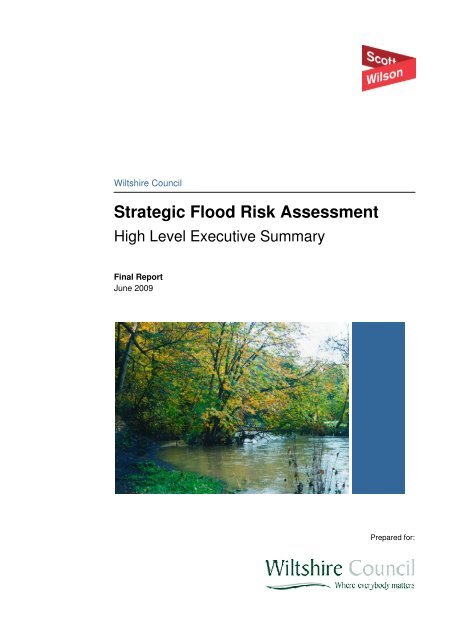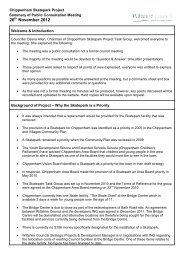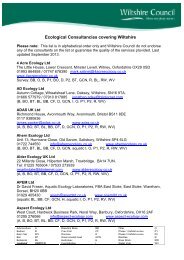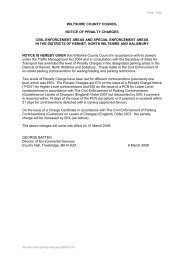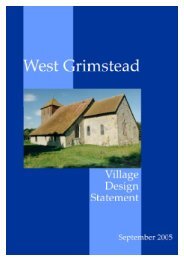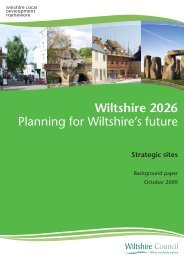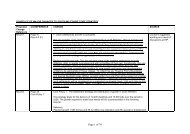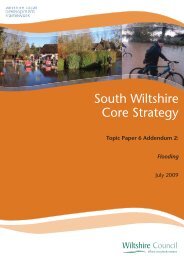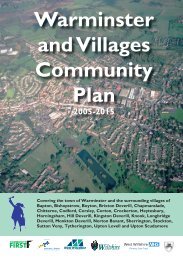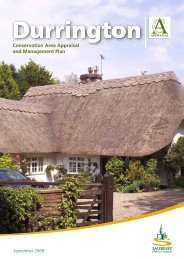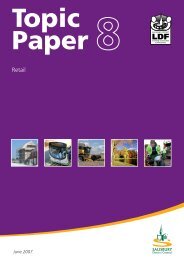Strategic Flood Risk Assessment - Wiltshire Council
Strategic Flood Risk Assessment - Wiltshire Council
Strategic Flood Risk Assessment - Wiltshire Council
Create successful ePaper yourself
Turn your PDF publications into a flip-book with our unique Google optimized e-Paper software.
<strong>Wiltshire</strong> <strong>Council</strong><strong>Strategic</strong> <strong>Flood</strong> <strong>Risk</strong> <strong>Assessment</strong>High Level Executive SummaryFinal ReportJune 2009Prepared for:
<strong>Wiltshire</strong> <strong>Council</strong>SFRA High Level Executive SummaryGlossaryTerm1 in 100 yearevent1 in 100 yeardesign standard<strong>Flood</strong> Zone 1<strong>Flood</strong> Zone 2<strong>Flood</strong> Zone 3a<strong>Flood</strong> Zone 3b –Functional<strong>Flood</strong>plain<strong>Flood</strong> defence<strong>Flood</strong>plain<strong>Flood</strong> storageareaFluvial floodingMitigationmeasure<strong>Risk</strong>Sustainabledrainage systemSustainabledevelopmentDefinitionEvent that on average will occur once every 100 years. Also expressed as anevent, which has a 1% probability of occurring in any one year.<strong>Flood</strong> defence that is designed for an event, which has an annual probability of1%. In events more severe than this the defence would be expected to fail or toallow flooding.This zone comprises of land assessed as having a less than 1 in 1000 annualprobability of fluvial or tidal flooding in any year (0.1%).This zone comprises land assessed as having between a 1 in 100 year and 1 in1000 year annual probability of fluvial flooding (1% - 0.1%) or between a 1 in 200year and a 1 in 1000 year annual probability of tidal flooding (0.5% - 0.1%) in anyyear.This zone comprises land assessed as having a 1 in 100 or greater annualprobability of fluvial flooding (>1%) or a 1 in 200 or greater annual probability oftidal flooding (>0.5%) in any year.This zone comprises land where water has to flow or be stored in times of flood.SFRAs should identify this <strong>Flood</strong> Zone (land which would flood with an annualprobability of 1 in 20 (5%) or greater in any year or is designed to flood in anextreme (0.1%) flood, or at another probability to be agreed between the LPA andthe Environment Agency, including water conveyance routes).Infrastructure used to protect an area against floods as floodwalls andembankments; they are designed to a specific standard of protection (designstandard).Area adjacent to river, coast or estuary that is naturally susceptible to flooding.A temporary area that stores excess runoff or river flow often ponds or reservoirs.<strong>Flood</strong>ing by a river or a watercourse.An element of development design which may be used to manage flood risk oravoid an increase in flood risk elsewhere.The probability or likelihood of an event occurring.Methods of management practices and control structures that are designed todrain surface water in a more sustainable manner than some conventionaltechniques.Development that meets the needs of the present without compromising the abilityof future generations meeting their own needs.2 June 2009
<strong>Wiltshire</strong> <strong>Council</strong>SFRA High Level Executive Summary1 Introduction1.1 Background1.1 Scott Wilson Ltd was commissioned in December 2008 to provide a high level executivesummary for the commencement of <strong>Wiltshire</strong> <strong>Council</strong> (April 2009). This summary drawstogether the information provided in the Level 1 <strong>Strategic</strong> <strong>Flood</strong> <strong>Risk</strong> <strong>Assessment</strong>s (SFRAs)produced for the individual Local Planning Authorities (LPAs) that are being integrated toform a single unitary authority of <strong>Wiltshire</strong> <strong>Council</strong>. The LPAs being integrated are:• North <strong>Wiltshire</strong> District <strong>Council</strong> (NWDC);• Kennet District <strong>Council</strong> (KDC);• West <strong>Wiltshire</strong> District <strong>Council</strong> (WWDC); and• Salisbury District <strong>Council</strong> (SDC).1.2 This report summarises information on the application of the Sequential Test, a broad scaleassessment of flood risk for potential strategic developments, flood risk managementmeasures for consideration for new developments, recommendations for flood risk policyand site specific <strong>Flood</strong> <strong>Risk</strong> <strong>Assessment</strong> (FRA) guidance.1.3 In addition, there will be a brief overview of the collation of the datasets and theaccompanying Geographical Information System (GIS) layers for use by <strong>Wiltshire</strong> <strong>Council</strong>along with recommendations on the maintenance and update of data sources for futuredecision making.1.4 The accompanying GIS layers will also be used to inform the Minerals and Waste LocalDevelopment Framework and the Minerals and Waste Level 1 SFRA is being updated intandem with this document. This will ensure that the available data is consistent across the<strong>Wiltshire</strong> <strong>Council</strong> administrative area, providing continuity in the decision making process.3 June 2009
<strong>Wiltshire</strong> <strong>Council</strong>SFRA High Level Executive Summary2 Sequential Test2.1 What is the Sequential Test?2.1.1 The Sequential Test refers to the application of the sequential approach by LPAs. Thisallows the determination of site allocations based on flood risk and vulnerability (see Table2-1 and Table 2-2, provided below). Development should be directed to <strong>Flood</strong> Zone 1wherever possible, and then sequentially to <strong>Flood</strong> Zone 2 and then <strong>Flood</strong> Zone 3. Where asite lies spans different flood zones, a sequential approach based on vulnerability ofdevelopment should be undertaken steering development to the areas of least risk.Table 2-1: PPS25 <strong>Flood</strong> Zone Definitions (These ignore the presence of defences)<strong>Flood</strong> Zone<strong>Flood</strong> Zone 1DefinitionLow probability - less than 0.1% (1 in 1000 year) probability of floodingeach year from fluvial or tidal flooding.<strong>Flood</strong> Zone 2 Medium probability - between 0.1% and 1% (between 1 in 1000 and 1in 100 year) probability of fluvial flooding each year and between 0.1%and 0.5% (between 1 in 1000 and 1 in 200 year) probability of tidalflooding each year .<strong>Flood</strong> Zone 3a<strong>Flood</strong> Zone 3bHigh probability - 1% or greater (1 in 100 year or greater) probability offluvial flooding each year and a 0.5% or greater (1 in 200 year orgreater) probability of tidal flooding each year.Functional floodplain - land where water has to flow or be stored intimes of flood. Defined as the 5% (1 in 20 year) annual probabilityfloodplain or an area designed to flood in an extreme (0.1%) flood, oranother probability agreed between the LPA and the EnvironmentAgency. (The Environment Agency do not currently produce <strong>Flood</strong>Zone 3b mapping for England and Wales).2.1.2 The application of the Sequential Test aims to manage the risk from flooding by avoidance.This avoids the promotion of sites that are inappropriate on flood risk grounds. Theapplication of the Exception Test, where required, through a Level 2 SFRA will ensure thatnew developments in flood risk areas will only occur where flood risk is clearly outweighedby other sustainability drivers.2.1.3 The LPA must demonstrate that it has considered a range of possible sites in conjunctionwith the <strong>Flood</strong> Zone information from the SFRA and applied the Sequential Test, and wherenecessary, the Exception Test, in the site allocation process.2.1.4 PPS25 acknowledges that some areas will (also) be at risk of flooding from flood sourcesother than fluvial or tidal systems. Consequently all sources of flooding must be consideredwhen looking to locate development in any of the flood zones. The other sources of floodingrequiring consideration when situating new development allocations include:• Surface water;• Groundwater;• Sewers; and,• Artificial sources.4 June 2009
<strong>Wiltshire</strong> <strong>Council</strong>SFRA High Level Executive Summary2.1.5 These sources (as sources of flooding) are typically less well understood than tidal andfluvial sources. Data often only exists as point data or through interpretation of localconditions. In addition, there is no guidance on suitable return periods to associate withfloods arising from these sources. When assessing these sources through the SequentialTest, if a location is recorded as having experienced significant flooding from other sourcesor repeated flooding from the same source this should be investigated further.Table 2-2: <strong>Flood</strong> <strong>Risk</strong> Vulnerability Classification (from PPS25, Table D2)EssentialInfrastructureHighlyVulnerableMoreVulnerableLessVulnerableWatercompatibleDevelopment• Essential transport infrastructure (including mass evacuation routes)which has to cross the area at risk, and strategic utility infrastructure,including electricity generating power stations and grid and primarysubstations.• Police stations, Ambulance stations and Fire stations and CommandCentres and telecommunications installations required to be operationalduring flooding.• Emergency dispersal points.• Basement dwellings.• Caravans, mobile homes and park homes intended for permanentresidential use.• Installations requiring hazardous substances consent.• Hospitals.• Residential institutions such as residential care homes, children’shomes, social services homes, prisons and hostels.• Buildings used for: dwelling houses; student halls of residence; drinkingestablishments; nightclubs; and hotels.• Non-residential uses for health services, nurseries and educationalestablishments.• Landfill and sites used for waste management facilities for hazardouswaste.• Sites used for holiday or short-let caravans and camping, subject to aspecific warning and evacuation plan.• Buildings used for: shops; financial, professional and other services;restaurants and cafes; hot food takeaways; offices; general industry;storage and distribution; non-residential institutions not included in‘more vulnerable’; and assembly and leisure.• Land and buildings for agriculture and forestry.• Waste treatment (except landfill and hazardous waste facilities).• Minerals working and processing (except for sand and gravel working).• Water treatment plants.• Sewage treatments plants (if adequate pollution control measures arein place).• <strong>Flood</strong> control infrastructure.• Water transmission infrastructure and pumping stations.• Sewage transmission infrastructure and pumping stations.• Sand and gravel workings.5 June 2009
<strong>Wiltshire</strong> <strong>Council</strong>SFRA High Level Executive Summary• Docks, marinas and wharves.• Navigation facilities.• MOD defence installations.• Ship building, repairing and dismantling, dockside fish processing andrefrigeration and compatible activities requiring a waterside location.• Water-based recreation (excluding sleeping accommodation).• Lifeguard and coastguard stations.• Amenity open space, nature conservation and biodiversity, outdoorsports and recreation and essential facilities such as changing rooms.• Essential ancillary sleeping or residential accommodation for staffrequired by uses in this category, subject to a specific warning andevacuation plan.2.2 Application of the Sequential Test2.2.1 The Sequential Test should be undertaken by the LPA and be accurately documented toensure the decision process is transparent and reviewed where necessary. The SequentialTest should be carried out on all development sites, seeking to balance the flood probabilityand development vulnerability of sites throughout the administrative area. Only where thereare no reasonably available alternative sites should development be considered in <strong>Flood</strong>Zones 2 and then <strong>Flood</strong> Zone 3. The Sequential Test also applies to any new planningapplication including allocated sites that pre-date PPS25 and all windfall sites (see Section2.4). The Environment Agency has recently revised their <strong>Flood</strong> <strong>Risk</strong> Standing Advice forLPAs regarding the Sequential Test and is available from their website 1 .2.2.2 Paragraph 4.15 of the PPS25 Practice Guide identifies that at a local level, the SequentialTest should be applied to the whole LPA area. In this instance, although the new boundaryof the <strong>Wiltshire</strong> <strong>Council</strong> will be the administrative area, the application of the Sequential Testshould be undertaken based on the existing district administrative boundaries prior to thecommencement of the single unitary authority. The reasoning for this is because the draftRSS has identified the number of dwellings per annum required for KDC, WWDC, NWDCand SDC. This is not being altered to reflect the change to a single unitary authority of<strong>Wiltshire</strong> <strong>Council</strong>.2.2.3 The Sequential Test can also be applied within an individual allocation with developmentbeing steered to the parts of the site least at risk from flooding, where achievable. Areasintended for green open space could be utilised for flood water storage or conveyancepositioned within areas with greater risk of flooding. This strategy allows a sustainableapproach to development allocation within the floodplain.2.2.4 The integrated GIS mapping (see Chapter 3) provides updated information for application ofthe Sequential Test. A review of strategic potential development options based oninformation provided within the existing Level 1 SFRAs is provided in Chapter 4, thisinformation will also help guide recommendations for individual sites. The flow diagramprovided in Figure 1 identifies recommended steps for undertaking the Sequential Test. Thisis based on the <strong>Flood</strong> Zone and <strong>Flood</strong> <strong>Risk</strong> Vulnerability summarised in Table 2-3.1 http://www.environment-agency.gov.uk/research/planning/82584.aspx6 June 2009
Preface and AcknowledgmentsixSome capitalization decisions will cause raised eyebrowson the European side of the Atlantic, where titles arenormally capitalized, for example, Emperor of Austria, asopposed to emperor of Austria or king of Italy. With respectto French titles, this work conforms to the French method,employing lower case for aristocracy, such as comte deProvence. Britons may find such forms as chancellor of theexchequer, leader of the House of Commons, and secretary ofstate for war and the colonies, rather offensive to the eyes;however, in an effort to bridge CMS style and scholarlyconvention I have tried (whether boldly or foolishly) toreach a compromise in favor of historians. It should benoted that the CMS does make concessions to using uppercasefor British aristocratic titles, if not so much for politicaloffices. This work has also deviated in some casesfrom the CMS with respect to the capitalization of Emperor,when referring to Napoleon, as well as with respectto (among others) Revolutionary, Romanticism, Allied, andAllies, the latter in refererence to belligerent states formingpart of a coalition against France. Conferred French titles,such as King of Rome, for Napoleon’s son, and King ofSpain, for Joseph, Napoleon’s brother, also appear capitalized,whereas this is not the case for hereditary titles.Hyphens used in the French language can pose particularproblems for an editor, not least because differentsources identify individuals both with and without hyphensbetween forenames. For example, Marie Louise appearssometimes with, sometimes without hyphens, dependingon the source.Punctuation presented various problems, not leastbecause, like grammar and spelling, it is employed slightlydifferently on either side of the Atlantic. It is of coursesimple enough to use American spelling uniformly, andthus one will not find centre, but center, and caliber insteadof calibre; while instead of whilst; that instead of which;waggon instead of wagon; color instead of colour; towardinstead of towards, and so on. The dominance of American,over British, English in this work is no more apparentthan in the presence of the split infinitive, abhorrent toBritish eyes and ears, yet a common and acceptable featureof English as spoken and written in North America.“To boldly go where no man has gone before” continues toproduce smiles of derision in Britain, and not for reasonsof poor grammar alone. Those accustomed to BritishEnglish will also note that this work follows the recentAmerican practice of dropping hyphens between compoundnouns or with ranks, thus producing such wordssuch antirevolutionary, noncommissioned, and Vice Admiral;still, I have allowed some hyphens to be retained, aswith demi-brigade, pro-royalist, and sans-culotte. The originalorthography for flêche (a V-shaped earthwork) is preferredover the more modern flèche.Where revolutionary refers specifically to the FrenchRevolution it appears capitalized: The French Revolutionaries;a wave of Revolutionary fervor; Revolutionarygovernments in France, and so on. Not so, however, forroyalist, republican, or other descriptive terms whichhave no association with a recognized major politicalmovement.The use of army and Army has been dictated by thefollowing rule: Where discussion focuses on the entire institution,it is capitalized; where it discusses a specific armyin the field or a specific fleet at sea, it is rendered in lowercase. Hence, it may be said that thousands of Irishmen enlistedin the British Army during the course of theNapoleonic Wars, whereas the British army landed in Portugalin 1808. Similarly, the Prussian Army underwent numerousreforms between 1808 and 1813, whereas thePrussian army in 1813 was led by General Gebhard vonBlücher. Readers should also note that where the termRoyal Navy appears, this is invariably a reference to thenaval establishment of Britain, there being no such institution,technically speaking, as the “British Navy,” in thesame way that one may properly refer to the U.S. Army butnot to the “American Army.”Where the names of armies do not always betray theirnationality, they are identified, thus: (French) Army ofItaly; (French) Army of Rome; (French) Army of Batavia;(Russian) Army of Poland; and so on.Personal NamesExcept in the cases of those known better by their aristocraticname, every effort has been made to supply the forenameas well as the surname of every individual mentionedin the text. Yet forenames are sometimes disputedby historians, and even an individual’s entire name can appearin various texts in a bewildering array of combinations,not least in the cases of Claude Perrin Victor andToussaint Louverture.There is also the conundrum of the manner by whichthe leader of France should be identified: whether Buonaparteas in his early years, Bonaparte somewhat later, orNapoleon (or, strictly properly, Napoléon) throughout.Bonaparte is used in the present work for the period untilhis assumption of the Imperial title in 1804, and Napoleonthereafter. Readers should therefore not be surprised tofind that the same person may appear as Bonaparte andNapoleon in the same entry, depending on the periodunder discussion. For obvious purposes of space and redundancy,readers will not find “Bonaparte, Napoleon” inthe “See also” section of the entries. Nor have Napoleonand Josephine been identified as Napoléon and Joséphinewhich, though technically correct, are very rarely renderedas such in an English-speaking context.
<strong>Wiltshire</strong> <strong>Council</strong>SFRA High Level Executive Summary2.3 Recommended Stages in Application of Sequential Test2.3.1 A sequence of stages are presented that provide a step by step application of theSequential Test (based on Figure 1) to guide the LPAs through the Sequential Test. Thesteps are designed to ensure land allocations are primarily allocated in line with theprinciples of the Sequential Test or failing this the requirement for application of theException Test is clearly identified.Recommended Stages for the LPAs1. Assign all potential allocations with a vulnerability classification (Table 2-2).Where development is proposed to be mixed, this should be moved to the higherclassification;2. The location and identification of potential development should be recorded e.g.SS 970461, Trowbridge #1;3. The flood zone classification of potential allocations should be determined basedon a review of the flood zones for fluvial and tidal sources as provided inaccompanying GIS layers. Where these span more than one flood zone, all zonesshould be noted;4. The design life of the development should be considered with respect to climatechange:• 60 years – for commercial / industrial developments;• 100 years – for residential developments; and,• The design life should begin from 2026 which is consistent with the duration ofthe Core Strategy.5. Identify if there are existing flood defences serving the potential development sitesbased on accompanying GIS layers;6. Highly vulnerable developments to be accommodated within the LPAs areashould be located within <strong>Flood</strong> Zone 1. If these cannot be located in <strong>Flood</strong> Zone 1,because the identified sites are unsuitable or there are insufficient sites in <strong>Flood</strong>Zone 1, sites in <strong>Flood</strong> Zone 2 can then be considered. If sites in <strong>Flood</strong> Zone 2 areinadequate then the LPAs may have to identify additional sites in <strong>Flood</strong> Zones 1or 2 to accommodate development or seek opportunities to locate thedevelopment outside their administrative area;7. Once all highly vulnerable developments have been allocated to a developmentsite, the LPAs can consider those development types defined as more vulnerable.More vulnerable development should be located in any unallocated sites in <strong>Flood</strong>Zone 1. Where these sites are unsuitable or there are insufficient sites remaining,sites in <strong>Flood</strong> Zone 2 can be considered. If there are insufficient sites in <strong>Flood</strong>Zone 1 or 2 to accommodate more vulnerable development, sites in <strong>Flood</strong> Zone3a can be considered. More vulnerable developments in <strong>Flood</strong> Zone 3a willrequire application of the Exception Test;8. Once all more vulnerable developments have been allocated to a developmentsite, the LPAs can consider those development types defined as less vulnerable.Less vulnerable development should be located in any remaining unallocatedsites in <strong>Flood</strong> Zone 1, continuing sequentially with <strong>Flood</strong> Zone 2, then <strong>Flood</strong> Zone8 June 2009
<strong>Wiltshire</strong> <strong>Council</strong>SFRA High Level Executive Summary3a. Less vulnerable development types are not appropriate in <strong>Flood</strong> Zone 3b(functional floodplain);9. Essential infrastructure should be preferentially located in the lowest flood riskzones, however, this type of development may be located in <strong>Flood</strong> Zones 3a and3b, provided the Exception Test is fulfilled;10. Water compatible development has the least constraints with respect to flood riskand it is considered appropriate to allocate these sites last;2.3.2 For the above stages, it will also be necessary to consider the risks posed to the site fromother flood sources and where comparable, development sites in the same flood zone maybe more suitable due to:• <strong>Flood</strong> risk management measures;• The rate of flooding;• <strong>Flood</strong> water depth; or,• <strong>Flood</strong> water velocity.2.3.3 Where the development type is highly vulnerable, more vulnerable, less vulnerable oressential infrastructure and a site is found to be impacted by a recurrent flood source (otherthan tidal of fluvial), the site and flood sources should be investigated further regardless ofany requirement for the Exception Test. These may be assessed either through a Level 2SFRA, Surface Water Management Plan or a site specific FRA.2.3.4 The effect of climate change for potential allocations should be considered for those locatedwithin fluvial and tidal flood zones, these are provided in the accompanying GIS layers. It isrecommended that where required, a Level 2 SFRA or a site specific <strong>Flood</strong> <strong>Risk</strong><strong>Assessment</strong> should investigate the effects of climate change in greater detail.2.4 Windfall Sites2.4.1 PPS25 requires the application of the Sequential Test to all planning applications in floodrisk areas, including those on previously developed land, unless the area or site has alreadybeen allocated through a Sequential Test informed by an SFRA. Windfall sites are sites thatbecome available for development during plan period but have not been allocated within adevelopment plan that has been sequentially tested. The LPA should develop policies intheir LDDs on how windfall sites should be treated in flood risk terms.2.4.2 The PPS25 Practice Guide indicates that LPAs should identify areas where windfalldevelopment would be constituted as appropriate development i.e. defining the type ofwindfall development which would be acceptable in certain flood risk areas and what thebroad criteria should be for submitting a planning application under these circumstances. Itis suggested that where a windfall site becomes available, appropriate development optionsshould take into account the vulnerability classification (Table 2-2) and the availability ofsites with lower flood risks.2.4.3 Planning Policy Statement 3 (PPS3): Housing indicates that LPAs should not makeallowances for windfalls in their plans for the first 10 years of land supply. Only where LPAscan demonstrate genuine local circumstances that prevent specific sites being identified9 June 2009
<strong>Wiltshire</strong> <strong>Council</strong>SFRA High Level Executive Summaryshould windfall sites be considered within this timeframe. Windfall sites should be subject tothe same consideration of flood risk as other housing development.2.4.4 The Sequential Test should be applied to windfall sites, unless the area in which they occurhas been sequentially tested on the basis of a SFRA. If the Sequential Test has not beenapplied to the area, proposals will need to be dealt with on an individual site basis and thedeveloper will need to provide evidence to the LPA that they have adequately consideredother reasonably available sites. This will involve considering the windfall site against othersites allocated in plans.10 June 2009
<strong>Wiltshire</strong> <strong>Council</strong>SFRA High Level Executive Summary3 Collation and Review of Datasets3.1 Overview3.1.1 This chapter provides details on the collation of the GIS datasets accompanying the existingLevel 1 SFRAs. The datasets have been integrated to provide an accessible format whichwill enable <strong>Wiltshire</strong> <strong>Council</strong> to determine flood risk to future development sites across the<strong>Wiltshire</strong> <strong>Council</strong> administrative area. The integrated datasets will allow <strong>Wiltshire</strong> <strong>Council</strong> toundertake the Sequential Test and identify where the Exception Test may be required.3.2 Collation of GIS Datasets3.2.1 The integrated datasets are shown in Table 3-1. Due to variation within each district of theavailability of data collected during the Level 1 SFRA process, some integrated datasets areshown to cover only parts of the study area.3.2.2 It is important that the methodologies and limitations of the datasets are understood beforethe mapping is used for planning purposes. The existing Level 1 SFRAs provide a detaileddescription, including the methodologies used to generate the GIS datasets shown in Table3-1.Table 3-1: Key Level 1 SFRA GIS datasets provided by the LPAsKey Datasets KennetNorth<strong>Wiltshire</strong>Salisbury West <strong>Wiltshire</strong>Current <strong>Flood</strong> Zones 2 and 3 a/bClimate Change <strong>Flood</strong> Zone 3 a/bMain Rivers Sub-catchment BoundariesArtificial <strong>Flood</strong> Source NFCDD Structures NFCDD Defences <strong>Flood</strong> Storage Areas FRIS Incidents FRIS Properties Groundwater<strong>Flood</strong>ing DatabaseLocalised <strong>Flood</strong>ingDatabaseSewer <strong>Flood</strong>ingWessex WaterHistoric <strong>Flood</strong>Outlines 11 June 2009
<strong>Wiltshire</strong> <strong>Council</strong>SFRA High Level Executive SummaryKey Datasets KennetNorth<strong>Wiltshire</strong>Salisbury West <strong>Wiltshire</strong>Reservoirs <strong>Flood</strong> Warning <strong>Flood</strong> Watch(Hampshire Avon) 3.3 Review of GIS Datasets3.3.1 The Environment Agency updates their flood maps on a quarterly basis, incorporating theresults of detailed studies where relevant. <strong>Wiltshire</strong> <strong>Council</strong> have provided updated extents(dated October 2008) of the Environment Agency flood maps to ensure any revisions areincluded in the integrated GIS datasets produced for this high level executive summary.3.3.2 A comparison of existing individual Level 1 SFRAs <strong>Flood</strong> Zones 2 and 3 with the updated<strong>Flood</strong> Zones 2 and 3 provided by the Environment Agency has been undertaken. Althoughthe majority of the flood zones are unchanged, flood zone revisions have been noted andupdated in the following areas:• River Ebble – <strong>Flood</strong> Zone 3 extent north east of Nunton (Salisbury);• Middle River Kennet – <strong>Flood</strong> Zone 2 and 3 extent within Marlborough, includingareas upstream and downstream of the settlement (Kennet);• Middle River Kennet – <strong>Flood</strong> Zone 2 and 3 extent in the vicinity of Mildenhall,Axford, Ramsbury and Chilton Foliat (Kennet);• Upper River Thames – <strong>Flood</strong> Zone 3 extent in the vicinity of Ashton Keynes(North <strong>Wiltshire</strong>).3.4 Update and Maintenance3.4.1 SFRAs should be considered as ‘live’ documents where regular review and monitoringshould be undertaken to ensure that the best available data on flood risk issues is beingused to inform <strong>Wiltshire</strong> <strong>Council</strong> planning decisions.3.4.2 It is suggested that the GIS layers should form the ‘live’ part of the document. GIS layerupdates should run parallel with the Annual Monitoring Report that typically provideinformation on progress of Local Development Documents, local economy and environment.3.4.3 It is understood that the Environment Agency update their <strong>Flood</strong> Zone mapping on aquarterly basis and this is distributed to LPAs. It is recommended that a comparison ofexisting and updated <strong>Flood</strong> Zones is undertaken to identify significant changes in <strong>Flood</strong>Zone 2 and 3. This is particularly important where these have been used as surrogates foreither climate change or Functional <strong>Flood</strong>plain (<strong>Flood</strong> Zone 3b) as described within theexisting Level 1 SFRAs.3.4.4 It is recommended that where Functional <strong>Flood</strong>plain (<strong>Flood</strong> Zone 3b) is disputed andchanges agreed, these should be recorded to ensure ongoing data maintenance. Where asurrogate has been used to define Functional <strong>Flood</strong>plain i.e. the whole of <strong>Flood</strong> Zone 3 hasbeen considered as Functional <strong>Flood</strong>plain (<strong>Flood</strong> Zone 3b) in the absence of detailed12 June 2009
<strong>Wiltshire</strong> <strong>Council</strong>SFRA High Level Executive Summarymodelling data, it is suggested that a three way discussion between the Developer,Environment Agency and <strong>Wiltshire</strong> <strong>Council</strong> is undertaken. Where revisions are agreed thatdo not affect the extent of <strong>Flood</strong> Map outline reference to Paragraphs 4.78 to 4.86 in thePPS25 Practice Guidance should be made to substantiate these changes.3.4.5 It is recommended that where hydraulic modelling has been undertaken to revise the extentof <strong>Flood</strong> Zone 3a and Functional <strong>Flood</strong>plain (<strong>Flood</strong> Zone 3b), a joint agreement processbetween <strong>Wiltshire</strong> <strong>Council</strong> and the Environment Agency <strong>Flood</strong> <strong>Risk</strong> Mapping and DataManagement Team should be undertaken. Where a challenge to the areal extent of a <strong>Flood</strong>Zone is successful, the Environment Agency <strong>Flood</strong> Map and SFRA Map should illustrate thesame outline in future updates. These should be identified through an annual appraisal ofmajor planning applications within flood risk areas and reported.3.4.6 It is recommended that a data request to the relevant Environment Agency Offices isundertaken on an annual basis to identify additional information of flooding from othersources such as groundwater, surface water, sewers and artificial sources.3.4.7 In addition, it is recommended that a data request to the relevant Statutory WaterUndertakers is undertaken on an annual basis to identify additional information on sewerflooding from their DG5 register. This may identify where either new issues have beenidentified or known issues have been resolved.3.4.8 It is recommended that during the Annual Monitoring Report process, a review of existingPlanning Policy Statements or associated guidance is undertaken to identify wheresignificant updates may require significant revision of the SFRA.13 June 2009
<strong>Wiltshire</strong> <strong>Council</strong>SFRA High Level Executive Summary4 Broad Scale <strong>Assessment</strong> of <strong>Flood</strong> <strong>Risk</strong>4.1 Overview4.1.1 This chapter provides a broad-scale assessment of flood risk at the district level based oninformation provided within the existing Level 1 SFRAs. As discussed within Chapter 2, dueto the housing allocation structure within the draft RSS the application of the Sequential Testshould be undertaken based on the existing district administrative boundaries.4.1.2 Each district level broad-scale assessment includes an overview of flood risk posed topotential development sites within the main settlements, identified within the existing Level 1SFRAs. Guidance on where there may be a requirement for further work in the form of aLevel 2 SFRA and/or Surface Water Management Plans (SWMPs) is also provided.4.2 District Level Broad Scale <strong>Assessment</strong>Kennet District• Residential and commercial properties, transport links and agricultural land have beensubjected to damage and disruption by fluvial, surface water, sewer and groundwaterflooding. Specific areas where groundwater flooding has been recorded include villagesin close proximity to the Hampshire River Avon, River Bourne and the River Og;• Eleven properties (September 2007) have been identified as being currently at risk fromsewer flooding. Wessex Water are currently undergoing works to eliminate the majorityof foul sewage flooding incidents by 2010;• There are two reservoirs that are considered under the Reservoir Act 1975 (volumegreater than 25000 m 3 ). There are no potential development sites, identified within theKDC Level 1 SFRA, located directly downstream of a reservoir. However, if futuredevelopment is proposed downstream of these reservoirs a site specific FRA will berequired to assess the potential flood risk;• All of the main settlements, as identified in Table 4-1 have potential development sites(identified by KDC) located within <strong>Flood</strong> Zone 1. Four of the main urban settlementshave potential development sites entirely, or part located within Climate Change <strong>Flood</strong>Zones 3b and 3a;• The Environment Agency <strong>Flood</strong> Zone 2 and 3 extents (see Section 3.3) in the vicinity ofMarlborough have been updated since the publication of the KDC Level 1 SFRA. Areview of the potential development sites within Marlborough, as identified withinAppendix E of the KDC Level 1 SFRA, indicates that the extent of <strong>Flood</strong> Zone 2 and 3across certain sites has changed (see Figure 2). It is important that the updated GISlayers accompanying this high level executive summary are used to ensure strategicplanning decisions are made using the best available information.14 June 2009
<strong>Wiltshire</strong> <strong>Council</strong>SFRA High Level Executive SummaryTable 4-1: <strong>Flood</strong> zone classification for the potential development sites within the mainurban areas within KDCSettlementPotentialdevelopmentsites intersectwith <strong>Flood</strong> Zone1Potentialdevelopmentsites intersectwith ClimateChange <strong>Flood</strong>Zone 3bPotentialdevelopmentsites intersectwith ClimateChange <strong>Flood</strong>Zone 3aOther floodsourceswithinurban areaDevizes Marlborough Tidworth Pewsey MarketLavington Ludgershall iiiFigure 2: Revised extent of Environment Agency <strong>Flood</strong> Zone 2 (light blue) and<strong>Flood</strong> Zone 3 (dark blue) across potential development sites within Marlborough.The Functional <strong>Flood</strong>plain, <strong>Flood</strong> Zone 3b (Pink) extent remains unchanged. (i)<strong>Flood</strong> zone extents as presented within the KDC Level 1 SFRA (ii) Updated(October 2008) flood zone extents accompanying this high level executivesummary.15 June 2009
<strong>Wiltshire</strong> <strong>Council</strong>SFRA High Level Executive SummaryNorth <strong>Wiltshire</strong> District• Fluvial flooding has been experienced within Chippenham, Calne, Malmesbury andCricklade in recent years. Properties, transport links and agricultural land has beensubject to damage and disruption;• Surface water flooding has been experienced in Wootton Bassett, Calne, Malmesburyand Marston Meysey affecting properties and transport links. The nature of theunderlying geology means that groundwater flooding is less significant than othersources, although isolated occurrences have been recorded;• Twenty six properties have been identified as being currently (September 2007) at riskfrom sewer flooding. Wessex Water are currently undergoing works to eliminate themajority of foul sewage flooding incidents by 2010;• There are four reservoirs that are considered under the Reservoir Act 1975 (volumegreater than 25000 m 3 ). There are no potential development sites, identified within theNWDC Level 1 SFRA, located directly downstream of a reservoir. However, if futuredevelopment is proposed downstream of these reservoirs a site specific FRA will berequired to assess the potential flood risk;• Four of the main settlements identified in Table 4-2 have potential development sitesthat intersect with Climate Change <strong>Flood</strong> Zone 3b and 3a. All of the main settlementshave potential development sites located within <strong>Flood</strong> Zone 1;• The Environment Agency <strong>Flood</strong> Zone 2 and 3 extents (see Section 3.3) in the vicinity ofAshton Keynes have been updated since the publication of the NWDC Level 1 SFRA. Areview of the potential development sites within the vicinity of Ashton Keynes, asidentified within Appendix D of the NWDC Level 1 SFRA, indicates that the revisedflood zone extents within the identified sites are unchanged.Table 4-2: <strong>Flood</strong> zone classification for the potential development sites within the mainurban areas within North <strong>Wiltshire</strong>SettlementPotentialdevelopmentsites intersect<strong>Flood</strong> Zone 1Potentialdevelopmentsites intersectwith ClimateChange <strong>Flood</strong>Zone 3bPotentialdevelopmentsites intersectwith ClimateChange <strong>Flood</strong>Zone 3aOther floodsourceswithinurban areaChippenham Calne WoottonBassett Corsham Malmesbury 16 June 2009
<strong>Wiltshire</strong> <strong>Council</strong>SFRA High Level Executive SummarySettlementPotentialdevelopmentsites intersect<strong>Flood</strong> Zone 1Potentialdevelopmentsites intersectwith ClimateChange <strong>Flood</strong>Zone 3bPotentialdevelopmentsites intersectwith ClimateChange <strong>Flood</strong>Zone 3aOther floodsourceswithinurban areaCricklade Salisbury District• Domestic and commercial properties, transport links and farmland have been subjectedto damage and disruption by fluvial, surface water and groundwater flooding;• Four properties (September 2007) have been identified as being currently at risk fromsewer flooding. Wessex Water are currently undergoing works to eliminate the majorityof foul sewage flooding incidents by 2010;• There are 21 reservoirs, five of which are considered under the Reservoir Act 1975(volume greater than 25000 m 3 ). Proposed development downstream of thesereservoirs will require a site specific FRA to assess the potential flood risk;• <strong>Flood</strong> depth maps for the 1 in 100 year event within Tisbury, Downton and Salisburyare provided within the existing Level 1 SFRA. These maps can be used as anindication of where to direct development to reduce flood risk;• Within SDCs administrative area, areas of search have been identified by the originalhousing topic paper 2 , which supports the Core Strategy Preferred Options document 3 .A preliminary review undertaken, as part of the existing Salisbury Level 1 SFRAindicates that four out of seven ‘Areas of Search for Development’ intersect withClimate Change <strong>Flood</strong> Zones 3b and 3a. A similar approach was undertaken for theexisting urban areas within Salisbury identified in Table 4-3 below. This indicates thatall the main settlements have urban areas located within <strong>Flood</strong> Zone 1 althoughpotential development sites within these towns have not been identified within the Level1 SFRA.Table 4-3: <strong>Flood</strong> Zone classification for the main urban areas within SalisburySettlementUrban areaintersect with<strong>Flood</strong> Zone 1Urban areaintersect withClimate Change<strong>Flood</strong> Zone 3bUrban areaintersect withClimate Change<strong>Flood</strong> Zone 3aOther floodsourceswithinurban areaSalisbury Tisbury Wilton Mere 2 http://www.salisbury.gov.uk/topic2-housing.pdf3 http://www.salisbury.gov.uk/core-strategy-preferred-options.pdf17 June 2009
<strong>Wiltshire</strong> <strong>Council</strong>SFRA High Level Executive SummarySettlementUrban areaintersect with<strong>Flood</strong> Zone 1Urban areaintersect withClimate Change<strong>Flood</strong> Zone 3bUrban areaintersect withClimate Change<strong>Flood</strong> Zone 3aOther floodsourceswithinurban areaDownton Amesbury Bulford Durrington Shrewton West <strong>Wiltshire</strong> District• Fluvial and surface water flooding has been experienced in Bradford on Avon,Melksham, Trowbridge, Warminster and Westbury in recent years affecting properties,transport links and agricultural land. The nature of the underlying geology means thatgroundwater flooding is not significant;• Fifteen properties (September 2007) have been identified as being currently at risk fromsewer flooding. Wessex Water are currently undergoing works to eliminate the majorityof foul sewage flooding incidents by 2010;• There are four reservoirs that are considered under the Reservoir Act 1975 (volumegreater than 25000 m 3 ). There are no potential development sites, identified within theWWDC Level 1 SFRA, located directly downstream of a reservoir. However, if futuredevelopment is proposed downstream of these reservoirs a site specific FRA will berequired to assess the potential flood risk;• All of the main settlements (see Table 4-4) have potential development sites (asidentified by WWDC) located within <strong>Flood</strong> Zone 1. Melksham and Westbury also havepotential development sites that intersect with Climate Change <strong>Flood</strong> Zone 3b and 3a;• The revised Environment Agency <strong>Flood</strong> Zone 2 and 3 extents (see Section 3.3) areunchanged from the flood zones presented within WWDC Level 1 SFRA. However it isconsidered best practice to use the GIS layers accompanying this report to ensureconsistency throughout the <strong>Wiltshire</strong> <strong>Council</strong> administrative area.Table 4-4: <strong>Flood</strong> zone classification for the potential development sites within the mainurban areas within West <strong>Wiltshire</strong>SettlementBradford onAvonPotentialdevelopmentsites intersectwith <strong>Flood</strong> Zone1Potentialdevelopmentsites intersectwith ClimateChange <strong>Flood</strong>Zone 3bPotentialdevelopmentsites intersectwith ClimateChange <strong>Flood</strong>Zone 3aOther floodsourceswithinurban area 18 June 2009
<strong>Wiltshire</strong> <strong>Council</strong>SFRA High Level Executive SummarySettlementPotentialdevelopmentsites intersectwith <strong>Flood</strong> Zone1Potentialdevelopmentsites intersectwith ClimateChange <strong>Flood</strong>Zone 3bPotentialdevelopmentsites intersectwith ClimateChange <strong>Flood</strong>Zone 3aOther floodsourceswithinurban areaMelksham Trowbridge Warminster Westbury 4.3 The Location of Future Development4.3.1 The broad-scale assessment of flood risk, provided in Section 4.2, indicates that within eachdistrict there are available sites for development located within <strong>Flood</strong> Zone 1. Where a siteconsists of land located in more than one flood zone the development should besequentially located within the site boundary to ensure those developments that arevulnerable are located within the lowest risk flood zones.4.3.2 Under certain circumstances other sustainability objectives considered by <strong>Wiltshire</strong> <strong>Council</strong>may result in sites located in <strong>Flood</strong> Zones 2, 3a and 3b being taken into account. In suchcases, further work at the Level 2 SFRA stage may be required to satisfy the ExceptionTest.4.3.3 Level 2 SFRA work is currently being undertaken for two specific sites within Salisbury(Churchfields Industrial Estate and Central Car Park / the Maltings). These sites are partiallylocated within <strong>Flood</strong> Zones 2 and 3. The Level 2 SFRA work will provide detailed informationon flood risk and flood risk management at the potential development sites.4.3.4 Based on the information presented within the existing Level 1 SFRAs together with theEnvironment Agency Catchment <strong>Flood</strong> Management Plans (CFMPs) Existing areas inChippenham, Salisbury and Malmesbury may require further information through additionalhydraulic modelling to inform potential flood alleviation options, to mitigate against theanticipated effects of climate change.4.3.5 To investigate feasible options to reduce flood risk these in urban areas a joint approachworking with the Environment Agency should be adopted. In addition, within the settlementsof Warminster and Britford SWMPs are likely to be required to manage the risk of surfacewater flooding.4.3.6 It is noted that the Swindon Water Cycle Strategy is emerging and includes the ‘west ofSwindon growth area’. This growth area is undergoing a site selection process where fromten initial sites, three preferred sites have been identified. In some instances, thesepreferred sites lay within the administrative boundary of <strong>Wiltshire</strong> <strong>Council</strong> and it is thoughtthat development can be fully accommodated within <strong>Flood</strong> zone 1. The Environment Agencyhas identified that a Level 2 SFRA may be required due to the size of the development(3000 houses) to consider other sources of flooding.19 June 2009
<strong>Wiltshire</strong> <strong>Council</strong>SFRA High Level Executive Summary5 <strong>Flood</strong> <strong>Risk</strong> Management5.1 Overview5.1.1 This section provides an overview of flood risk management practices including commentaryon flood defence infrastructure, flood warning and Sustainable Drainage Systems (SuDS).5.2 Existing <strong>Flood</strong> Defences5.2.1 <strong>Flood</strong>ing may occur across areas of the study area with minimal effect to people, buildings,infrastructure or the economy, however, in some areas there may be a significant effect.Where required, flood defences are usually focused in and around the urban areas wherefor social, economic and sustainability reasons these are required to minimise disruption toindividuals, businesses and the wider community.5.2.2 Environment Agency <strong>Flood</strong> Maps do not account for the presence of flood defences whendelineating the <strong>Flood</strong> Zone extent and therefore areas of land situated behind thesedefences are still attributed with a flood risk. The presence of flood defences does notremove the risk for the areas protected as failure through overtopping or breaching mayoccur, therefore, a residual flood risk remains.5.2.3 <strong>Flood</strong> defences generally fall into one of two categories: ‘formal’ or ‘defacto’. A ‘formal’defence (termed ‘raised defence (man-made) in NFCDD) is a structure which has beenspecifically built to control floodwater. It is maintained by its owner (this is not necessarilythe Environment Agency) so that it remains in the necessary condition to function.5.2.4 A ‘defacto’ defence includes road and rail embankments and other linear infrastructure(buildings and boundary walls) which may act as water retaining structures or createenclosures to form flood storage areas in addition to their primary function. Other structuresare identified on the Environment Agency database, but these have not necessarily beenbuilt to control floodwater and are not maintained for this purpose.5.2.5 Mapping of the formal flood defences held within the NFCDD database has been providedwithin the existing Level 1 SFRAs. Integrated NFCDD man-made defence and structure GISdatasets have been produced as part of this high level executive summary covering the<strong>Wiltshire</strong> <strong>Council</strong> administrative area.5.3 <strong>Flood</strong> Warning Procedures5.3.1 The Environment Agency undertakes a considerable amount of work in terms of floodwarning procedures. The Environment Agency operates a flood warning service in all areasat risk of flooding, which is available on their website 4 .5.3.2 Within the study area there are a number of flood watch areas. <strong>Flood</strong> watch areas arehydrologically similar (or groups of catchments). Within each flood watch area are focussedareas, known as flood warning areas, where flooding is known to occur during larger floodevents.4 http://www.environment-agency.gov.uk/homeandleisure/floods/31618.aspx20 June 2009
<strong>Wiltshire</strong> <strong>Council</strong>SFRA High Level Executive Summary5.3.3 The flood warnings are disseminated through a variety of mediums that include TV, radio,and <strong>Flood</strong>line Warnings Direct, which is a service direct to a phone/fax/pager/internet.Loudhailers are also used in certain circumstances. There is also an emergency <strong>Flood</strong>linenumber (0845 988 1188) and a quick dial number for individual rivers.5.3.4 The Environment Agency aim to give a minimum of two hours warning prior to the onset of aflood event. However the rapid onset of some flood events, after a breach in flood defencesor following a period of high intensity rainfall, means that sufficient warning cannot alwaysbe raised.5.3.5 <strong>Flood</strong> warning areas have been mapped and presented within the existing Level 1 SFRAs.Integrated GIS datasets, showing both flood watch and flood warning areas within the<strong>Wiltshire</strong> <strong>Council</strong> administrative area have been provided as part of this high level executivesummary.5.3.6 Groundwater flood warnings are in place where the permeable nature of the underlying soiland geology presents a potential flood risk to local properties, such as Salisbury Plain.Groundwater flood warnings are issued on a parish basis, where it is the responsibility of theparish warden is for issuing flood warnings.5.4 Sustainable Drainage of Development SitesOverview5.4.1 Sustainable Drainage Systems (SuDS) are the preferred method for managing the surfacewater run-off generated by developed sites. Both PPS1 (Delivering SustainableDevelopment) and PPS25 require that LPAs should promote their use for the managementof runoff. SuDS seek to manage surface water as close to its source as possible, mimickingsurface water flows arising from the site, prior to the proposed development. Typically thisapproach involves a move away from piped systems to softer engineering solutions inspiredby natural drainage processes.5.4.2 SuDS should be designed to take into account the surface run-off quantity, rates and alsowater quality ensuring their effective operation up to and including the 1 in 100 year designstandard flood including an increase in peak rainfall of 30% to account from climate change.5.4.3 Wherever possible, SuDS techniques should seek to contribute to each of the three goalsidentified below with the favoured system contributing significantly to each objective. Wherepossible SuDS techniques for a site should seek to:• Reduce flood risk (to the site and neighbouring areas);• Reduce pollution; and,• Provide landscape and wildlife benefits.5.4.4 These goals can be achieved by the SuDS management train, as outlined in ‘The SuDSManual’ (CIRIA, 2007), where each component adds to the performance of the wholesystem:• Prevention - good site design and upkeep to prevent runoff and pollution (e.g.limited paved areas, regular pavement sweeping);21 June 2009
<strong>Wiltshire</strong> <strong>Council</strong>SFRA High Level Executive Summary• Source control - runoff control at/near to source (e.g. rainwater harvesting,green roofs, permeable pavements);• Site control - water management from a multitude of catchments (e.g. routewater from roofs, impermeable paved areas to one infiltration/holding site); and,• Regional control - integrate runoff managed from a number of sites (e.g. into adetention pond).5.4.5 In keeping with the guidance of PPS25, local authorities should encourage the application ofSuDS techniques. This chapter presents a summary of the SuDS techniques currentlyavailable, enabling the local authorities to identify where SuDS techniques could beemployed in development schemes.5.4.6 The application of SuDS techniques is not limited to one technique per site. Often asuccessful SuDS solution will utilise a number of techniques in combination, providing floodrisk, pollution and landscape/wildlife benefits. In addition, SuDS can be employed on astrategic scale, for example with a number of sites contributing to large scale jointly fundedand managed SuDS, however, each development site must offset its own increase in runoffand attenuation cannot be “traded” between developments.5.4.7 Detailed design guidance can be found in the SuDS Manual C697, and associated SiteHandbook for the Construction of SuDS, C698. These publications provide best practiceguidance on the planning, design, construction, operation and maintenance of SuDS, toensure effective implementation within developments.SuDS Design5.4.8 SuDS techniques can be used to reduce the rate and volume of surface water runoff andimprove the water quality of surface water discharges from sites to the receivingenvironment (i.e. natural watercourse or public sewer etc).5.4.9 The design of SuDS measures should be undertaken as part of the drainage strategy anddesign for a development site. A ground investigation will be required to assess thesuitability of using infiltration measures, with this information being used to assess therequired volume of on-site storage. Hydrological analysis should be undertaken usingindustry-approved procedures, to ensure a robust design storage volume is obtained.5.4.10 During the design process, liaison should take place with the Local Planning Authority andthe Environment Agency in order to establish that the design methodology is satisfactoryand to also agree on a permitted rate of discharge from the site.5.4.11 A key consideration of SuDS design is the maintenance regime to ensure they operateeffectively, which should be sufficiently detailed and agreed at the design stage. Themaintenance regime should set out a framework with a clear identification of responsibilityfor the lifetime of the proposed development. Table 8-1 provides a summary of the differentSuDS techniques.22 June 2009
<strong>Wiltshire</strong> <strong>Council</strong>SFRA High Level Executive SummaryTable 8-1: Summary of SuDS techniques and their suitability to meet the three aims for sustainability (see Section 9.2)ManagementTrainRegionalSiteSourcePreventionComponent Description Water Quantity Water QualityGreen roofsRainwater harvestingPermeablepavementsFilter drainsInfiltration trenchesKey: ● – highly suitable, ○ - suitable depending on design, - not suitableAmenityBiodiversityLayer of vegetation or gravel on roof areas providingabsorption and storage. ● ● ●Capturing and reusing rainwater for domestic orirrigation uses. ● ○ ○Infiltration through the surface into underlying layer. ● ● ○Drain filled with permeable material with aperforated pipe along the base. ● ● Similar to filter drains but allows infiltration throughsides and base. ● ● Soakaways Underground structure used for store and infiltration. ● ● Bio-retention areasSwalesSand filtersBasinsPondsWetlandVegetated areas used for treating runoff prior todischarge into receiving water or infiltration ● ● ●Grassed depressions, provides temporary storage,conveyance, treatment and possibly infiltration. ● ● ○Provides treatment by filtering runoff through a filtermedia consisting of sand. ● ● Dry depressions outside of storm periods, providestemporary attenuation, treatment and possiblyinfiltration.Designed to accommodate water at all times,provides attenuation, treatment and enhances siteamenity value.● ● ○● ● ●Similar to ponds, but are designed to providecontinuous flow through vegetation. ● ● ●23 June 2009
<strong>Wiltshire</strong> <strong>Council</strong>SFRA High Level Executive SummaryWhere can SuDS be Utilised?5.4.12 The underlying ground conditions of a development site will often determine the type of SuDSapproach to be used at development sites. This will need to be determined through groundinvestigations carried out on-site; however an initial assessment of a site’s suitability to the useof SuDS can be obtained from a review of the available soils/geological survey of the area.5.4.13 The existing Level 1 SFRAs provide information on the type of SuDS suitable for the underlyingsoil and geology within each individual district, prior to the commencement of the single unitaryauthority.SuDS Constraints5.4.14 There are several constraints that may limit the application of SuDS. These will vary betweenlocations and may include:• Ground Contamination;• Ground Conditions;• Ground Use / Vulnerability;• Capacity of the receiving watercourse.Ground Contamination5.4.15 Ground contamination has the potential to contaminate groundwater and/or surface waterresources if incorrectly managed. In some cases the nature of the ground contamination maybe such that certain types of SuDS are not appropriate. Ground contamination should bedetermined by site investigation on a site be site basis.Groundwater Use / Vulnerability5.4.16 Groundwater resources can be vulnerable to contamination from both direct sources (e.g. intogroundwater) or indirect sources (e.g. infiltration of discharges onto land). A review of theNational Rivers Authority (now the Environment Agency) groundwater vulnerability map can beused to identify the groundwater vulnerability on and surrounding a potential development site.5.4.17 The vulnerability of the groundwater is important when determining the suitability of SuDS. TheEnvironment Agency should be consulted on proposals where it is proposed to discharge togroundwater.Groundwater Source Protection Zones5.4.18 The Environment Agency also defines groundwater Source Protection Zones (SPZ). SPZs aredefined to protect areas of groundwater that are used for potable (drinking) supply, includingpublic/private potable supply, (including mineral and bottled water) or for use in the productionof commercial food and drinks.5.4.19 Depending on the nature of the proposed development and the location of the development sitewith regards to the SPZs, restrictions may be placed on the types of SuDS appropriate to24 June 2009
<strong>Wiltshire</strong> <strong>Council</strong>SFRA High Level Executive Summarycertain areas. Consideration should be given to the SPZs when determining the suitability ofSuDS for development sites. Further information is available on the Environment Agencywebsite: www.environment-agency.gov.uk.Planning Considerations for SuDS5.4.20 The application of SuDS may require space on development sites to be set-aside. Earlyconsideration of SuDS will assist in determining the space required and identify methods tospread the management of storm water throughout a site using the Management Train principlepresented in the CIRIA report C697.5.4.21 The design of SuDS measures should be undertaken as part of a drainage strategy proposedduring the master planning of development sites. A ground investigation will be required toaccess the suitability of using infiltration SuDS, with this information also being used to assessthe required volume of on-site storage. Hydrological analysis should be undertaken usingindustry-approved procedures; to ensure a robust design storage volume is obtained. Theconsideration of utilising SuDS as part of a development will depend on many factors such as:• The underlying geology and drift layers;• The depth of the groundwater table;• Site slopes;• run-off quality;• Site restrictions;• Maintenance requirements;• Economical viability; and,• Groundwater protection and ecological considerations.5.4.22 The final drainage scheme and SuDS for a site should consider each of these elements in itsdesign.5.4.23 All relevant organisations should meet at an early stage of the drainage design process toagree on the most appropriate drainage system for the particular development. Theseorganisations may include the Local Authority, the sewerage undertaker, Highway Agency, andthe Environment Agency. Liaison with these organisations should focus on establishing asuitable design methodology, any restrictions and provision for the long-term maintenance ofthe feature.5.4.24 The most convenient vehicle for agreeing long-term management responsibilities is throughSection 106 of the Town and Country Planning Act. Under this, agreement for SuDSmaintenance can be a requirement of the planning application, forcing the issue to beaddressed.25 June 2009
<strong>Wiltshire</strong> <strong>Council</strong>SFRA High Level Executive Summary5.5 Raising <strong>Flood</strong> Defence Standards5.5.1 A design standard of 1 in 100 year annual probability is taken as the appropriate designstandard for fluvial defences. The majority of the flood defences within the study area currentlyhave a Standard of Protection (SoP) less than the 1 in 100 year annual probability. The SoPoffered by flood defences will be reduced further by the anticipated effects of climate changewith precautionary estimates indicating peak flows up to 20% greater than present.5.5.2 The costs of raising these defences to the 1 in 100 year design standard will vary considerably.The Salisbury Level 1 SFRA provides indicative costs for raising fluvial flood defences by alinear metre, these costs range from £500 to £3,000.5.5.3 Indicative capital costs for the provision of different types of flood defence have been providedbelow. Capital costs (CAPEX) for raising flood defences include the construction, preliminariesand site costs, enabling works and temporary works.5.5.4 The CAPEX used has been based on unit cost rates obtained from the Environment Agency 5 .The following tables provide indicative costs for the provision of new flood defence walls (Table5-1), new flood defence embankments (5.5.5 Table 5-2), upgrading of existing embankments (Table 5-3) and inclusion of outfall structures(Table 5-4).5.5.6 OPEX are the operational costs for a flood defence including maintenance and refurbishmentdepending on the proposed lifetime of the scheme. The following general assumptions havebeen made and can be applied to provide an indicative value for OPEX, these are:• Annual costs of maintenance of the flood defence are approximately 0.5% ofCAPEX; and• An allowance of 40% of the CAPEX should be made for refurbishment of the flooddefence every 25 years.Table 5-1: Indicative flood defence costs rates (per linear metre) – new walls (source:Environment Agency)Wall Height (m)Type of Wall
<strong>Wiltshire</strong> <strong>Council</strong>SFRA High Level Executive SummaryTable 5-2: Indicative flood defence cost rates (per linear metre) – new embankment (source:Environment Agency)Volume (m 3 )Volume 500-5,000 5,000-15,000 >15,000Cost Range (£/m 3 ) 31-116 29-53 17-31Average Cost(£/m 3 )* 75 40 25Average cost perlinear metre (£/m)* 900 480 300*An indicative volume of 12 m 3 per metre run of defence has been used within the calculations.Table 5-3: Upgrading flood defence indicative costs rates (per linear metre) (source:Environment Agency)Type of Upgrade£/mRebuild & Raise Hard Defences 4,800Strengthen embankment with sheet pile 3,600Additional capping to sheet pile 900Table 5-4 Indicative costs of new and refurbished outfall (source Environment Agency)Type of Outfall £New Small outfall (900mm) 540,000Refurbished Small outfall (900mm) 270,0005.5.7 The values provided by the Environment Agency within Table 5-3 and Table 5-4 have beenincreased by 20% to provide a conservative estimate of the increase in cost from originalstudies.5.5.8 In addition to the capital costs, the Environment Agency maintains defences within the studyarea through a programme of repairs and upkeep of flood defence structures. This includesgrass cutting, desilting, maintenance of drains, debris removal and scrub clearance.27 June 2009
<strong>Wiltshire</strong> <strong>Council</strong>SFRA High Level Executive Summary6 Policy Recommendations6.1 Overview6.1.1 For the purpose of development control, detailed policies will need to be set out by <strong>Wiltshire</strong><strong>Council</strong> to ensure that flood risk is taken account of appropriately for both allocated and nonallocatedsites. This chapter provides a comprehensive summary of the Level 1 SFRA policyrecommendations to ensure a consistent approach to flood risk throughout the <strong>Wiltshire</strong><strong>Council</strong> administrative area.6.2 Catchment Wide Strategies• <strong>Wiltshire</strong> <strong>Council</strong> should adopt the climate change flood zones, (see accompanying GISlayers) including, where available, any additional flood risk areas identified in the historicalflood map as the extent of ‘critical drainage problem areas’ to define flood risk areas forthe purpose of article 10 of the Town and Country Planning (General DevelopmentProcedure) Order 1995 as amended by the <strong>Flood</strong> Directive 2007;• A Planning Application falling in a ‘critical drainage problem area’ or on a site exceedingone hectare should not be considered for registration without a <strong>Flood</strong> <strong>Risk</strong> <strong>Assessment</strong>(FRA) (see Section 7). The FRA should be prepared in accordance with PPS25 and<strong>Council</strong> Development Control policies;• It is not appropriate to use conditions to require the submission of a <strong>Flood</strong> <strong>Risk</strong><strong>Assessment</strong> (FRA) or details to support a FRA which cannot be demonstrated in the FRAto be practicable and / or acceptable in terms of other planning considerations;• A development should not increase flood risk on site or elsewhere, and where possible,opportunities should be taken to decrease overall flood risk;• Where development is proposed in areas bordering onto areas defined as ‘critical drainageproblem areas’ floor levels should be set above the 1 in 100 year fluvial or other flood levelwhere the critical drainage problem area is identified due to other sources of flooding. Forcritical drainage problem areas the predicted maximum flood level for the life of thedevelopment should be calculated with an allowance for climate change, plus a minimumfreeboard of 600mm;• The development should be safe throughout its life, to achieve this dry pedestrian egressshould be possible above the 1 in 100 year fluvial flood level and emergency vehicularaccess should be possible during times of extreme flood (an extreme flood event is anevent with an annual probability of between 1% (1 in 100 year) and 0.1% (1 in 1000 year)).Should dry access not be possible, occupants should be able to egress the developmentto land outside the floodplain unaided. The evacuation route should not require people toenter into flood water which is considered a danger for some, which includes children, theelderly or infirmed as identified in FD2320 6 . An evacuation plan should be prepared andthe advice from the Local Authorities emergency planning officer and the emergencyservices must be sought;6 FD2320 report can be accessed at the ‘<strong>Flood</strong> <strong>Risk</strong> for New Development’ website - http://www.hydres.co.uk28 June 2009
<strong>Wiltshire</strong> <strong>Council</strong>SFRA High Level Executive Summary• SuDS should be implemented to ensure that runoff from the site (post development) iseither to greenfield runoff rates where the site is undeveloped at present or providebetterment, where possible, where the site is previously developed. This should includespace set-aside within the confines of the site to allow its implementation. The use ofSuDS techniques and attenuation should take into account the local geological andgroundwater conditions. Should the surface water drainage system be designed to currentstandards for adoption, then; the surface water generated by a peak rainfall intensity, forall events up to that with an annual probability of 1%, in excess of the systems designedcapacity shall be contained on site without causing a risk to property. The design peakrainfall intensity shall include the climate change allowances set out in Table B.2 of PPS25appropriate to the design life of the development. ;• Basements should not be used for habitable purposes. Where basements are permittedfor commercial and ancillary use, it is necessary to ensure that the basement accesspoints and any venting or other penetrations are situated 600mm above the 1 in 100 yearfluvial level plus the climate change predicted maximum level for the life of thedevelopment;• Development should be set-back from watercourses to allow appropriate access forroutine maintenance and emergency clearance, if necessary. Any works or structures in,under, over or within 8 metres of the top of the bank of a main river are controlled underthe terms of the Water Resources Act 1991 and the Land Drainage Byelaws. This requiresa separate consent which is administered by the Environment Agency. Developmentshould not propose culverting or the building over of watercourses;• In areas protected to an appropriate standard by flood defences or down slope of waterretaining structures (reservoirs) a detailed breach and overtopping assessment shall becarried out to inform the Sequential Test and to ensure that the potential risk to life can besafely managed throughout the lifetime of the development. Unless absolutely necessary,flood defences should not be used as an option to make development within higher floodrisk areas permissible due to the risks of flood defence failure;• Protect undeveloped floodplain from future development and where opportunities ariseseek to increase the area of floodplain within urban areas, to restore natural river formsand floodplains (through managed reinstatement of floodplain where possible) and in sodoing restore river corridors and floodplains as areas of biodiversity and improved amenityvalue;• Opportunities should be sought to open culverted watercourses, where possible, to returnthem to a natural system. When opening up culverted watercourses consideration shouldbe given to ensure flood risk is not exacerbated downstream;• Routine monitoring of all watercourses should be undertaken to ensure they are clear ofdebris that could reduce flow conveyance and water quality;• Development should not have a detrimental impact on the water environment throughchanges to water chemistry or resource and this should be ensured through the use ofdrainage systems which limit the occurrence of pollution to the water environment;• Developments should look to incorporate water re-use and minimisation technology forexample green roofs and water butts. This will aid developments in contributing to the29 June 2009
<strong>Wiltshire</strong> <strong>Council</strong>SFRA High Level Executive SummaryCode for Sustainable Homes and will help in adoption of source control SuDS as part ofPPS25 requirements.6.3 Area Specific Strategies• In Chippenham, where deep and fast flood water flows can occur, opportunities to directwater away from areas of high social impact should be identified;• In rural areas upstream of Malmesbury, Melksham and Chippenham opportunities shouldbe sought to increase flood storage areas capacity, including an additional storageallowance for increases in flow accounting for climate change;• Opportunities should be sought for strategic flood storage areas in close proximity to futuredevelopment areas to be maintained by developer contribution for the lifetime of thedevelopment;• In Bradford on Avon, where fluvial and surface water flooding can occur, opportunities todirect water away from areas of high social impact should be identified;• In Warminster, opportunities should be sought to open culverted watercourses, wherepossible, to return them to a natural system. When opening up culverted watercoursesconsideration should be given to ensure flood risk is not exacerbated downstream;• In the application of SuDS techniques it is recommended that priority is given to the use ofsurface water drainage techniques due to the generally permeable soils throughoutSalisbury. Prior to implementing these techniques, each site should confirm that the use ofinfiltration drainage will not increase the risks of groundwater flooding.30 June 2009
<strong>Wiltshire</strong> <strong>Council</strong>SFRA High Level Executive Summary7 Site Specific FRA Guidance7.1 Overview7.1.1 The existing Level 1 SFRAs, together with this high level executive summary presents sufficientinformation to assist LPAs to apply the Sequential Test and identify where the Exception Testmay be required. The broad scale assessment undertaken for a Level 1 SFRA providessufficient detail to identify flood zones relevant to potential and existing allocations but is not ofsufficient resolution to provide a detailed assessment within them.7.1.2 A site specific <strong>Flood</strong> <strong>Risk</strong> <strong>Assessment</strong> (FRA) aims to refine the available information andminimise these risks through site design, layout and where required, mitigation. This chapterpresents the recommendations for site specific FRAs prepared for submission with planningapplications in the <strong>Wiltshire</strong> <strong>Council</strong> administrative area. Prior to committing expenditure orother resources on an FRA, consideration should be given to the ability of a site to pass theSequential Test.7.2 When is a FRA Required?7.2.1 When informing developers of the requirements of a FRA for a development site, considerationshould be given to the position of the development relative to flood sources, the vulnerability ofthe proposed development and its scale. The Environment Agency website provides standingadvice on the requirement of FRAs for developers and LPAs 7 .7.2.2 In the following situations a FRA should always be provided with a planning application:• The development site is located in <strong>Flood</strong> Zone 2 or 3;• The site area of proposed development is greater than 1 ha and located in <strong>Flood</strong>Zone 1;• The development site is located in an area known to have critical floodingproblems from any flood source;• The development is located within 20 m of any watercourse regardless of <strong>Flood</strong>Zone classification; and• Liaison with the LPA identifies the requirement for a FRA.7.3 FRA Requirements7.3.1 Annex E of PPS25 presents the minimum requirements for FRA. These include:• Consideration of the risk of flooding arising from the development in addition tothe risk of flooding to the development;7 http://www.environment-agency.gov.uk/research/planning/82584.aspx31 June 2009
<strong>Wiltshire</strong> <strong>Council</strong>SFRA High Level Executive Summary• Identify and quantify the vulnerability of the development to flooding from differentsources and identify potential flood risk reduction measures;• <strong>Assessment</strong> of the remaining ‘residual’ risk after risk reduction measures havebeen taken into account and demonstrate that this is acceptable for the particulardevelopment;• The vulnerability of those that could occupy and use the development, takingaccount of the Sequential and Exception Tests and the vulnerability classification,including arrangements for safe access;• Consideration of the ability of water to soak into the ground may change withdevelopment, along with how the proposed layout of development may affectdrainage systems; and,• Fully account for current climate change scenarios and their effect on flood zoningand risk.7.3.2 The Practice Guide to PPS25 advocates a staged approach to site specific FRA. The findingsfrom each stage inform the next stage iteratively throughout the development process. Thefollowing paragraphs describe the three levels of site specific FRAs.Level 1 - Screening Study7.3.3 A Level 1 Screening Study is intended to identify if a development site has any flood risk issuesthat warrant further investigation. This should be based on existing information such as thatpresented in the Level 1 SFRA. Therefore this type of study could be undertaken by a LandDrainage Engineer/Development Control Officer in response to the developer query or by adeveloper where the Level 1 SFRA is available. Using the information presented in the Level 1SFRA and associated GIS layers a Land Drainage Engineer/Development Control Officer couldadvise a developer of any flooding issues affecting the site. This information can then be usedby the developer as the basis to further their understanding of how the flood risks couldpotentially affect their development.Level 2 - Scoping Study7.3.4 A Level 2 Scoping Study is predominately a qualitative assessment designed to furtherunderstanding of how the flood sources affect the site and the options available for mitigation.The Level 2 FRA should be based on existing available information where this is available anduse this information to further a developers understanding of the flood risk and how it affectstheir development. This type of assessment should also be used to inform master plans of thesite raising a developer’s awareness of the additional elements the proposed development mayneed to consider.Level 3 – Detailed Study7.3.5 Where the quality and/or quantity of information for any of the flood sources affecting a site isinsufficient to enable a robust assessment of the flood risks, further investigation will berequired. For example, it is generally considered inappropriate to base a FRA for a residentialcare home at risk of flooding from fluvial sources on <strong>Flood</strong> Zone maps alone. In such cases theresults of hydraulic modelling are preferable to ensure details of flood flow velocity, onset of32 June 2009
<strong>Wiltshire</strong> <strong>Council</strong>SFRA High Level Executive Summaryflooding and depth of floodwater is fully understood and that the proposed developmentincorporated appropriate mitigation measures.33 June 2009
<strong>Wiltshire</strong> <strong>Council</strong>SFRA High Level Executive Summary8 Recommendations8.1 The Next StagePlanning Policy8.1.1 Based on the information presented in the existing Level 1 SFRAs and this high level executivesummary document, including the accompanying GIS layers, <strong>Wiltshire</strong> <strong>Council</strong> have sufficientinformation to apply the Sequential Test. The Sequential Test should be undertaken based onthe existing district administrative, due to the housing allocation structure within the draft RSS.8.1.2 Where there are insufficient sites in <strong>Flood</strong> Zone 1 to accommodate the required growth,consideration should be given to the vulnerability classification of the development to ensurethat it is located in an area of acceptable risk as defined in PPS25. In some cases this mayrequire application of the Exception Test.8.1.3 Where application of the Exception Test is required it will be necessary to undertake a Level 2SFRA. As provided within the PPS25 Practice Guide the scope of the Level 2 SFRA consists ofa more detailed assessment of the flood hazard to the development, which includesconsidering the following:• <strong>Flood</strong> probability;• <strong>Flood</strong> depth;• <strong>Flood</strong> velocity; and,• Rate of onset of flooding.8.1.4 This will allow informed decisions to be made regarding the safety of the development andwhether the development is achievable and deliverable in terms of sustainability.8.1.5 Where the Exception Test is required for a development, hydraulic modelling is normallyrequired to define the above flood characteristics. In the absence of existing detailed hydraulicmodelling, additional modelling work will be needed.Further Work8.1.6 Level 2 work is currently being undertaken for two specific sites within Salisbury, commissionedby SDC prior to the commencement of the unitary authority. The Environment Agency has alsoidentified that the ‘west of Swindon growth area’ may require Level 2 work to consider othersources of flooding, due to the size of the development (3000 houses).8.1.7 The Level 2 requirements for the rest of the <strong>Wiltshire</strong> <strong>Council</strong> administrative area will not beunderstood until the LPA has undertaken the Sequential Test within each of the districtadministrative boundaries.8.1.8 However, to mitigate against the anticipated effects of climate change further informationthrough additional hydraulic modelling may be required to inform potential flood alleviationoptions within existing urban areas of Chippenham, Salisbury and Malmesbury.34 June 2009
<strong>Wiltshire</strong> <strong>Council</strong>SFRA High Level Executive Summary8.1.9 Issues with surface water have been identified in Warminster, Bradford on Avon and Britford.Depending on development aspirations, these locations may benefit from a surface watermanagement plan to reduce flooding from this source in the future. In addition, areas identifiedfor regeneration provide opportunities for holistic consideration of surface water managementthrough such plans.8.1.10 Chapter 6 provides policy recommendations for area specific strategies, which LPAs shouldseek to incorporate into their emerging LDF.Level 1 SFRA Updates8.1.11 SFRAs should be considered as ‘live’ documents where regular review and monitoring shouldbe undertaken. The associated GIS layers can be readily updated and should be considered asthe best available data for the purposes of the Level 1 SFRA. GIS layers should be updated aspart of the annual monitoring process (see Section 3.4).35 June 2009


